
The direct mail offer you choose will have a huge impact on the response and ROI of your next direct mail campaign.
A good offer will generate high response. A less-than-enticing offer? Not so much. No offer at all? Don’t count getting responses.
Direct mail strategists spend a lot of time defining and refining offers because “What’s the offer?” is a question the creative team is sure to ask. Marketing and sales executives will certainly weigh in on this topic because the offer becomes essential in aligning direct mail strategy to execution.
What is a direct mail offer?
The offer in a direct mail piece is essentially the deal the recipient sees in your mailing. It spells out what you’re willing to give to a prospect or customer in exchange for a response.
In this direct mail piece, the offer is a discount — 20% off custom framing, so it’s pretty obvious what the deal is.
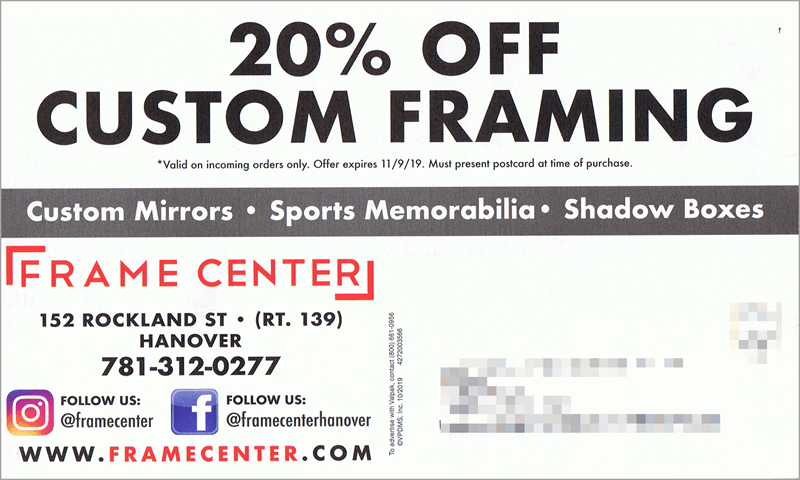
This is an example of one of the simplest offers you can make: “Buy now.” You’re selling something for a specific price and money changes hands. Sure, there may be a discount in some form or another, or perhaps a premium as an extra incentive, but the transaction is clearly defined.
In other cases, the offer doesn’t involve a purchase at all. In fact you may be giving away something free — perhaps a helpful guide to help consumers select a solar energy system. In a business-to-business setting, you might offer a free white paper, webinar, consultation, or other informational resource.
These types of offers are often used in complex sales because in these cases, while it’s unreasonable to expect that a customer is ready to buy now, you’d like to generate leads to identify who is most interested.
The offer, whether free or not, essentially represents a transaction. For a purchase, that’s easy to understand.
Yet even with a free offer, you’re expecting a prospect to provide their name, contact information, and perhaps other information in exchange for the free information or resources you are offering. In some cases you may be asking for a prospect’s time if you are providing a consultation.
Build your creative around your offer for best results
In our “Ultimate Guide To Direct Mailing List Selection And Testing”, we discussed how legendary direct marketer Edward Mayer defined the “40-40-20 rule” that states that direct marketing performance is 40% determined by the audience selection, 40% by the offer, and 20% by the creative.
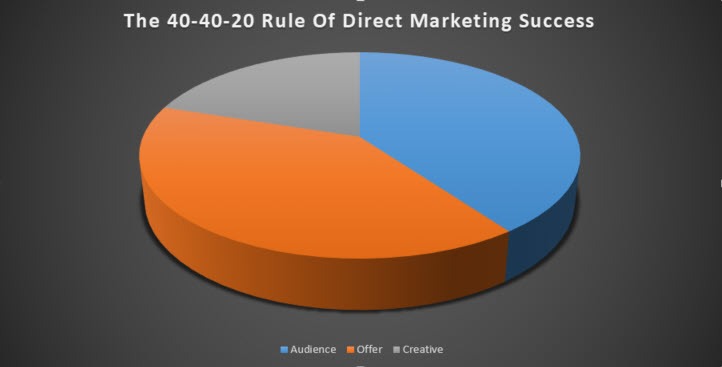
From processing millions of automated mail pieces per year, we’ve learned that this is generally true. Our experience has also shown us that there’s a proper sequence to develop each of these components:
- First select your audience
- Next select your offer
- Then build your creative around the offer
Why start with the audience and then build your offer? Consider the following table:
| Audience | Offer |
| Marketing Executives | Free Whitepaper Download |
| Local Artists | 20% Off Custom Framing |
While these offers could conceivably be given to either audience, marketing executives are more likely to be tempted to exchange some information for a whitepaper than are local artists. It’s pretty obvious who would be more likely to respond to a custom framing deal.
This is why it makes much more sense to choose an audience and then an offer, rather than the other way around.
If you are looking for response, conversion and ROI, you need to build your creative around your offer. The offer can’t be the last element thrown in at the end of the creative process.
Otherwise, your offer will be buried. Take a look at this postcard:
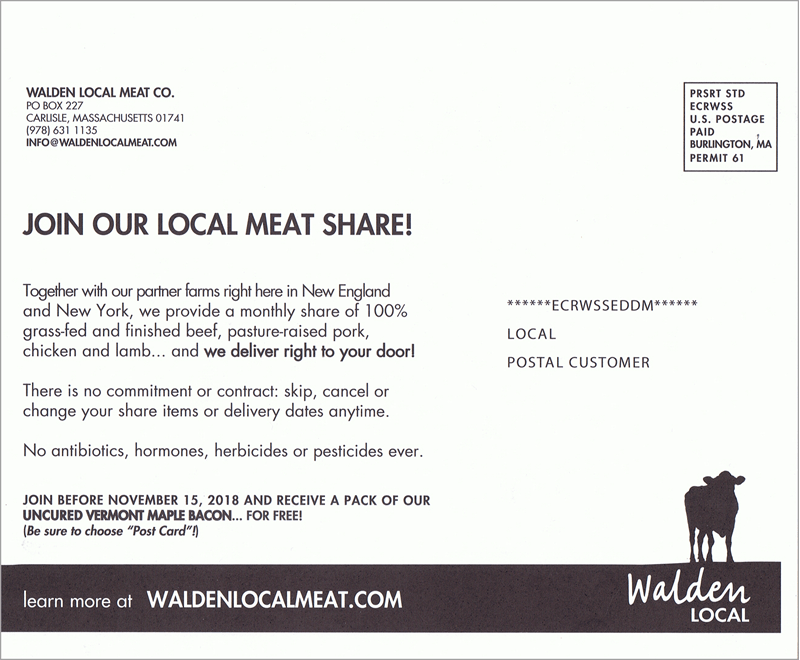
The offer isn’t clearly presented at all, and does not strongly support the mail call to action, “JOIN OUR LOCAL MEAT SHARE!” The offer appears as if it was simply jammed in after the rest of the copy was written and designed.
Compare the above to the below Whole Foods® flyer:
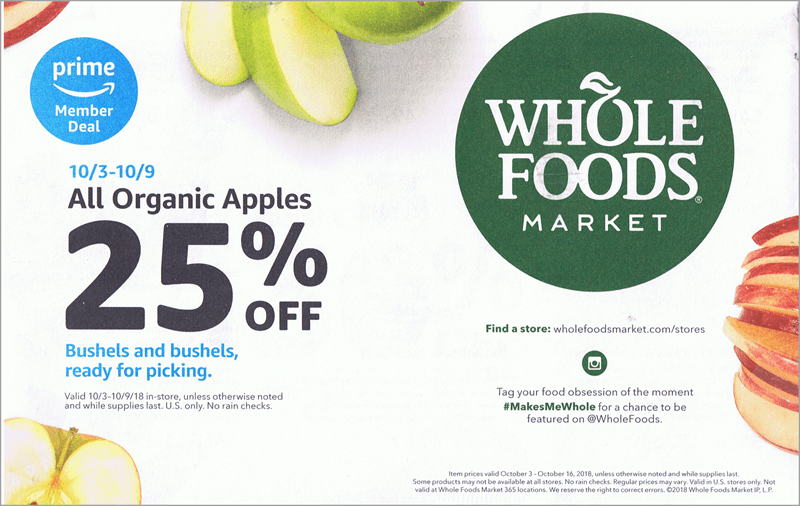
This offer is presented as the focal point of the entire piece, showing that when you build your creative around your offer, it becomes a more powerful element in your direct mail campaign.
“Better” offers yield higher response rates — but there’s a catch
Let’s look at a few examples of offers and how they impact response rates.
For our first example, we’ll consider a fairly simple consumer sale. We’ll assume that you’ve just opened a new outlet for your pizza chain in a new market and you want to establish yourself in that location by sending direct mail to nearby residents.
Consider three potential offers:
- Free pizza (just pay for delivery)
- One pizza at half price
- Buy one pizza, get a second pizza free
If we assume that a pizza costs $20 and delivery adds another $5, here’s how each offer measures up, in cost to the consumer.

Clearly the third offer costs more, but does add significant value in the form of a free pizza.
Let’s say you mail 10,000 direct mailers with each offer to test them. You might see response rates that look like this:
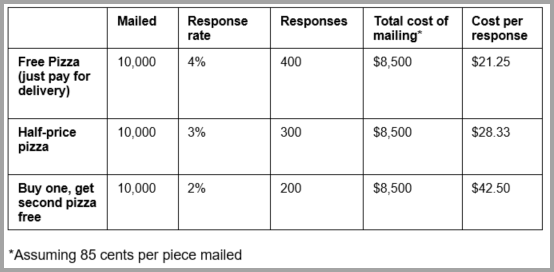
So is the best offer the first one? After all the cost per response was only $10.63.
Perhaps not.
In many cases like these, that first order may represent merely breaking even or even a slight loss. A loss leader. Your marketing goal is really to establish repeat business. You’ve already invested in marketing so if the customer experience is good, you may get repeat orders over an extended time period.
This is why marketing professionals often look at the lifetime value of a customer — in other words, the total revenue from that customer.
On the other hand, while that free pizza offer may be a good one, it may not generate a lot of repeat orders. After all, many will respond just to get a free pizza and never order again.
Those who respond to the third offer, buy one get one free (or BOGO) will usually not include as many people who only want a great deal.
What if you included a coupon with each BOGO offer and you continue analyzing these results? What’s the likelihood you’ll get a second order? A third order? Dozens more over the course of a few years?
Let’s take a look at how future orders might impact your costs and revenues initial orders:
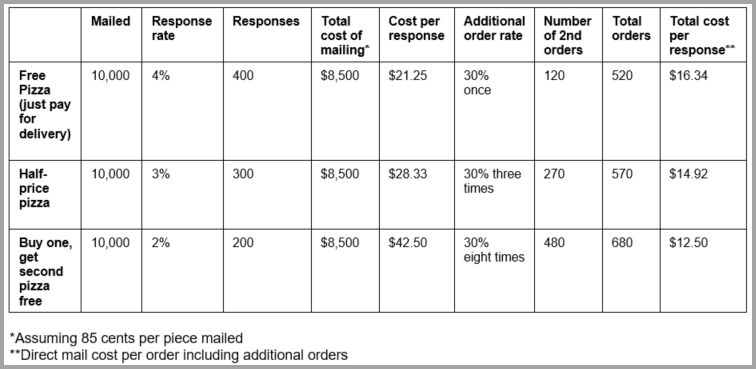
If, for example, 30 percent of that first group ordered one more time, you’d get 120 extra orders from that group – a total of 520 orders – bringing the cost of each order down from $21.25 to $16.34.
But if 30 percent of that third group that didn’t receive the best offer in the original mailing ordered eight more times over the course of a few months or so, you’d get another 480 orders for a total of 680. That reduces the total cost per response from the original mailing from $42,50 to $12.50 even though that offer initially delivered a lower response rate.
As you can see, it’s often the less enticing offer that delivers the best results over time because the audience is more committed, less likely to simply want a great deal one time.
Lead generation: How many leads do you want?
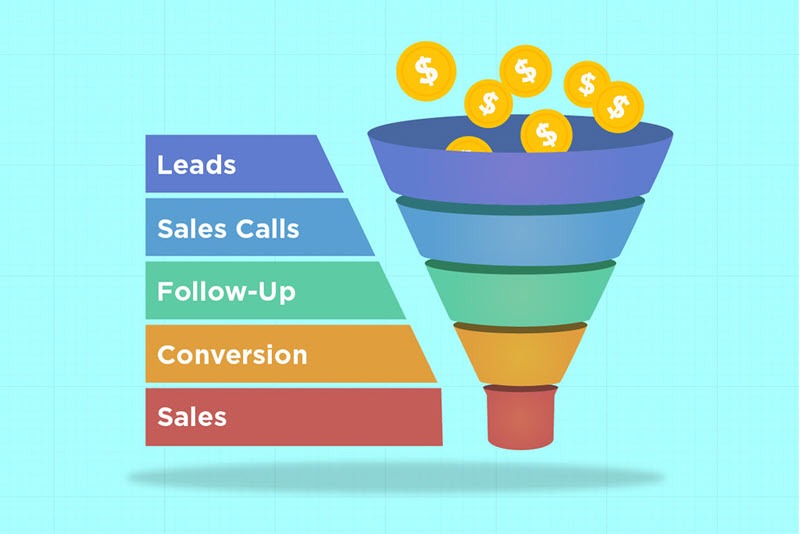
Turning to a more complex sale, perhaps in a business to business setting where a salesperson needs to generate leads, let’s take a look at how offer impacts results in such cases where a salesperson’s time is required to close the deal.
How many leads do want? If you say, “as many as possible,” you may not get the best results overall.
In many cases, more leads may not be better. Here’s why:
If you select the wrong enticing offer, you’ll certainly generate more leads, but they won’t likely be as qualified. Some offers represent high commitment on the part of the respondent, while others represent low commitment.
For example, if you’re selling a cloud-based accounting solution that costs several hundred dollars per year, you’d want to generate leads so your sales team can follow up. Here are some examples of offers you might consider:
- A low-commitment offer might be for a white paper that can be downloaded simply by clicking a link and receive a $10 Amazon gift card.
- A medium-commitment offer could be for the same white paper, but the prospect would need to fill out a form with specific contact information and answer some questions about their
business. - A high-commitment offer might take the form of scheduling a consultation with a sales executive.
If you tested these three offers with direct mail, the results might look like this:

It’s likely that the low-commitment offer would generate a higher response rate and the high-commitment offer would generate a lower response rate.
That’s because the many would respond simply to receive a gift card. Who wouldn’t?
But the goal is to produce qualified leads, not give away gift cards.
Those willing to spend time consulting with a salesperson, however, would be more likely to convert to a sale. The conversion rate is important because it represents total performance of your campaign. This chart shows what might be the overall results of this campaign including conversions:
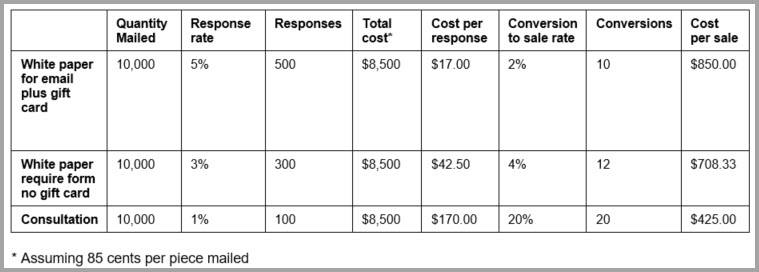
Not only do we reduce the cost per sale, but considering that your sales team has limited time, which would you prefer:
- 100 leads that would likely be of very high quality, or
- 500
leads, some of which may be of high quality but you would not know in advance
If 500 leads of unknown qualification would overwhelm your sales team, then you’d likely want to create a higher commitment offer.
In most cases, you’d want to use a split-run test, sending different offers to different prospects so you can accurately measure results to your initial mailing and the impact on future conversions.
Testing offers: Strike the right balance
These intricacies, your offer and how you present it, demonstrate why direct mail professionals spend a lot of time analyzing various options. It’s also why testing is so crucial to direct mail success.
As you can see from these examples, an offer that’s of high value may not be a good one because while initial response may be high, future orders and conversions may deliver you as much overall value to your direct mail campaign.
And offers that are not likely to generate high initial response may actually perform better when you do consider future orders and your conversion rate.
You can always mail offers that generate high response. Sure, high response rates may seem to be the goal for a direct mail campaign, but you need to strike the right balance between both response rates and the quality of response — so your entire campaign can be designed in a way that generates more repeat business and closes more sales.
Test Direct Mail Offers With Postalytics
If you’d like to test direct mail orders for yourself, automated tools like Postalytics simplify and speed up the production process, while providing detailed analytics regarding direct mail response.
Learn more by contacting us, or check out our how Postalytics works:
About the Author

Dennis Kelly
Dennis Kelly is CEO and co-founder of Postalytics, the leading direct mail automation platform for marketers to build, deploy and manage direct mail marketing campaigns. Postalytics is Dennis’ 6th startup. He has been involved in starting and growing early-stage technology ventures for over 30 years and has held senior management roles at a diverse set of large technology firms including Computer Associates, Palm Inc. and Achieve Healthcare Information Systems.
